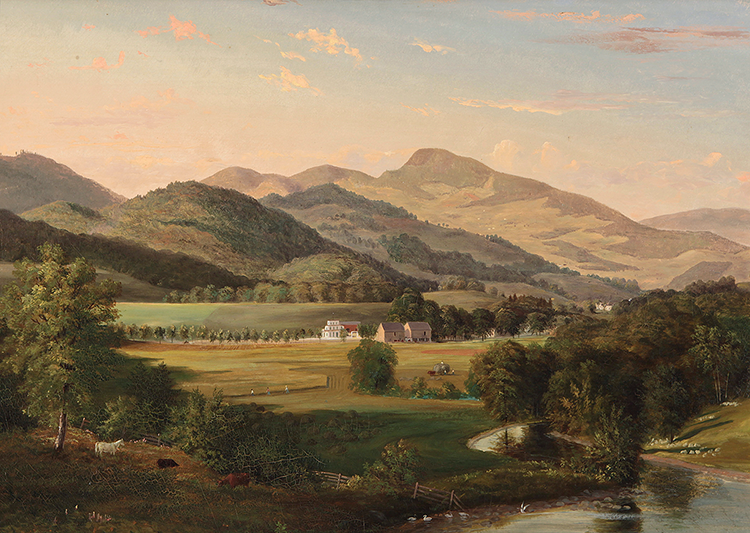
Landscape painting came into prominence in the visual arts of this land, now called the United States, in the early 1800s. Over the course of the century, the genre–with European roots–gained favor in the U.S., especially in the Northeast and among white artists and collectors. Many such paintings hold special significance today as historical records of European settler colonialism and as visual documents of environmental changes brought by humans.
Focusing on portrayals of Vermont and New England, Land Marks: Paintings of Human-Altered Landscapes brings together fifteen works, spanning roughly 1800 to the late 1900s. These paintings and a mirror, with a reverse painting on glass, infuse the Fleming’s Marble Court Balcony with color and with imagery that registers human interactions with the land.
The works in Land Marks show farms, cities, industrial buildings, and hydraulic structures. Once celebrated by some as signs of progress, these types of land use are increasingly under scrutiny today because they can–and often do–negatively impact the environment. Such changes to the land are depicted in James Hope’s painting Wedding Cake House, Iron Furnace Road, Pittsford, Vermont, from circa the early 1850s, which invites consideration of present-day concerns around agriculture and sustainability.
Many of the works in Land Marks also contain imagery that recalls current debates over land, fertilizer, herbicide, and water uses in Vermont. That is particularly so for representations of water systems and flows in landscape paintings by Henry Schnakenberg, Howard Giles, and Francis P. Colburn, all of which take on added significance when considered in the context of the flooding in Vermont last summer. Such works open thinking about current practices and their consequences for future generations.
Still, gaps in the Fleming’s holdings of landscape paintings are noticeable in this exhibition. Only two of its fifteen works are by women, Felicia Meyer Marsh and Yvonne Twining Humber, and none represent Indigenous peoples or give expression to their perspectives. That is partly because landscape paintings were traditionally made by–and for–mainly white Euro-American men and because the Fleming historically privileged acquiring such works. These disparities in the representation of women and Indigenous artists in the exhibition are examined in gallery labels and are part of ongoing conversations about evolving museum practice and experience.
Image: James Hope (United States, 1818–1892, b. Scotland), Wedding Cake House, Iron Furnace Road, Pittsford, Vermont, ca. early 1850s. Oil on canvas. Bequest of J. Brooks Buxton ’56 2019.1.4
